Scientists have long been puzzled by the stark difference in water abundance between Earth and Venus, despite the two planets being similar in composition and size. Recent research conducted by experts at the University of Colorado Boulder suggests that a non-thermal process known as ‘HCO+ Dissociative Recombination’ may hold the key to unraveling this mystery.
Dr. Michael Chaffin, a co-lead researcher of the study, shed light on the potential explanation behind Venus being bone dry compared to the water-rich Earth. The phenomenon of ‘HCO+ Dissociative Recombination’ is believed to have played a significant role in shaping the distinct water content of these neighboring planets.
Unlike traditional thermal processes, this non-thermal mechanism could have influenced the distribution of water molecules on Venus, leading to its current arid state. By delving into the intricacies of this process, scientists hope to gain a deeper understanding of the planetary evolution that resulted in such contrasting environments.
While Earth teems with water bodies and a vibrant ecosystem supported by this vital resource, Venus remains devoid of significant water reserves. The research findings highlight the importance of exploring unconventional processes like ‘HCO+ Dissociative Recombination’ in shaping planetary characteristics and conditions.
As scientists continue to unravel the mysteries of our solar system, the investigation into the water dichotomy between Earth and Venus offers valuable insights into the diverse mechanisms at play in planetary formation and evolution.





